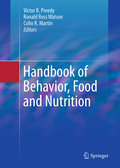
Handbook of behavior, food and nutrition
Preedy, Victor R.
Watson, Ronald Ross
Martin, Colin R.
This book disseminates current information pertaining to the modulatory effects of foods and other food substances on behavior and neurological pathways and, importantly, vice versa. This ranges from the neuroendocrine control of eating to the effects of life-threatening disease on eating behavior. The importance of this contribution to the scientific literature lies in the fact that food and eating are an essential component of cultural heritage but the effects of perturbations in the food/cognitive axis can be profound. The complex interrelationship between neuropsychological processing, diet, and behavioral outcome is explored within the context of the most contemporary psychobiological research in the area. This comprehensive psychobiology- and pathology-themed text examines the broad spectrum of diet, behavioral, and neuropsychological interactions from normative function to occurrences of severe and enduring psychopathological processes. Provides a new depth of information on the 'two-way traffic' of neurology,psychology, and behavioral aspects of food and diet Each chapter includes a section on applying information to related fields, as well as a key facts, summary points and defined key terms Everything you need to know about the behavioral aspects of food and nutrition: from molecular to individual through population levels INDICE: 1. General, normative aspects and overviews. 1.1 General and normative aspects: evolutionary and genetic. 1.2 General and normative aspects: sensory. 1.3 General and normative: endocrine and neuroendocrine. 1.4 General andnormative aspects: neurological. 1.5 General and normative aspects: behavioural and psychological. 1.6 General and normative aspects: physiological. 1.7 General and normative aspects: feeding and eating. 1.8 General and normative aspects: food choice, selection and preferences. 1.9 General and normative aspects: appetite. 1.10 General and normative aspects: fatty acids. 2. Pathological and abnormal aspects. 2.1 Pathology and abnormal aspects: genetic. 2.2 Pathology and abnormal aspects: sensory. 2.3 Pathology and abnormal aspects: endocrine and neuroendocrine. 2.4 Pathology and abnormal aspects: neurological. 2.5 Pathology and abnormal aspects: behavioural and psychological. 2.6 Pathology andabnormal aspects: physiological. 2.7 Pathology and abnormal aspects: feeding and eating. 2.8 Pathology and abnormal aspects: food choice, selection and preferences. 2.9 Pathology and abnormal aspects: appetite. 2.10 Pathology and abnormal aspects: lipids. 2.11 Pathology and abnormal aspects: miscellaneous topics. 3. Specific conditions and diseases. 3.1 Pregnancy. 3.2 Developmental, children and adolescents. 3.3 Starvation and nutrient deficiency. 3.4 Anorexia nervosa. 3.5 Bulimia nervosa and night eating syndrome. 3.6 Metabolic syndrome and non-obese-overweight. 3.7 Obesity. 3.8 Diabetes. 3.9 Nutrient excess and toxicity. 3.10 Ageing and Dementia. 3.11 Alcohol. 3.12 Quality of Life. 3.13 Body image. 4. Changing eating behaviour and attitudes. 4.1 The young and adolescents. 4.2 Adults and the elderly. 4.3 Other general or specific conditions. 5.Selective methods.
- ISBN: 978-0-387-92270-6
- Editorial: Springer New York
- Encuadernacion: Cartoné
- Páginas: 5000
- Fecha Publicación: 02/02/2011
- Nº Volúmenes: 5
- Idioma: Inglés
